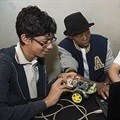Although the world is bracing itself for the influx of jobs of the future, as we welcome the fourth industrial revolution, the South African youth are still vulnerable in the labour market, with the youth unemployment rate among young people sitting at 38.2%, implying that more than one in every three young people in the labour force did not have a job in the first quarter of 2018 – according to Stats SA.
The reality, however, is that youth unemployment is not unique to South Africa, it is a global phenomenon. The International Labour Organisation (ILO) places the global number of unemployed youth, aged 15-24, at 71 million as of 2017, with many of them facing long-term unemployment.
Confidence in numbers
To circumvent these numbers and turn the tide of unemployment by creating employable youth – it is imperative that classrooms are redesigned to become conducive learning environments.
STEAM subjects (science, technology, engineering, art and mathematics) enable the classroom environment to transform into an incubation hub where students’ minds are stimulated to think innovatively and critically, when tackling engineering or technological problems, through imaginative designs and creative approaches. However, the adoption of STEAM subjects by students isn’t without its fair share of challenges.
A new Confidence in Learning Poll, fielded by The Harris Poll, on behalf of Lego Education, highlights the lack of confidence exhibited by students in the classroom. The study found that students need a hands-on approach to learning in order to build confidence and improve educational outcomes that prepare them for the future.
The global survey found that 51% of students expressed nervousness when trying new subjects at school. Adding to that, an even lower number of students (17%), are confident when it comes to learning STEAM subjects. Anxiety and a lack of confidence are recognised as the key challenges, by 76% of teachers, hindering the learning process among their students.
When asked about viable solutions to this pressing challenge, 95% of teachers said that hands-on learning builds students’ confidence. 87% of students were in agreement, saying that learning through hands-on projects allows them to remember the topics for longer. An even higher percentage of students, 89%, said that hands-on classroom activities effectively helps them understand these new subjects better. As a result of this, 91% of teachers said that they would like to integrate more hands-on lessons in their classroom.
The survey is indicative of the importance of adopting a hands-on approach to learning, which ultimately leads to improved confidence when learning STEAM subjects.
Building the workforce of the future
Earlier this year, Lego unveiled its new Spike Prime robotics kit – a whole new way of bringing STEAM subjects into the classroom. The new product is designed to help high school students (aged between 11-14 years of age) build their confidence in the classroom. By combining the physical and digital world through Lego bricks, sensors, motors and an intelligent hub, students are able to build fun and engaging creations, and then use the Spike App to bring those creations to life through Scratch-based coding. Through this kit, teachers are able to introduce cross-lesson plans into the classrooms in a manner that is relatable to students.
As far as STEAM learning goes, teachers and parents agree that the number one method for students to build confidence is by working on a hands-on project with others. The entire Lego Education portfolio, which now includes Spike Prime, was specifically designed to enable students to undertake a practical, hands-on approach to lessons, which effectively challenges them to think critically and creatively, to problem solve and to communicate efficiently with others.
In this environment, students are able to be active, collaborate with each other and build skills that will prepare them for the future.
It starts in the classroom
South Africa, along with many other countries, faces a STEAM skills shortage. A shortage that impacts the overall success of the country’s future workforce.
When these students are immersed in a classroom that utilises hands-on tools, their natural curiosity can be ignited, analytical capabilities sharpened, and their creativity unleashed. In doing so, they can succeed in their STEAM classes today and realise their full potential as digital citizens and leaders of tomorrow.
STEAM – the building blocks of a bright future
Given South Africa’s low unemployment rate, the adoption of STEAM subjects at high school level needs to be encouraged. In doing so, the youth can gain the necessary skillsets to become modern-day scientists, engineers and software developers, and even go on to become future drone pilots, IoT Architects and Virtual Reality Engineers.
Introducing tools into the classroom today, can effectively counter the effects of globally low unemployment rates with highly employable STEAM graduates in the future.







































